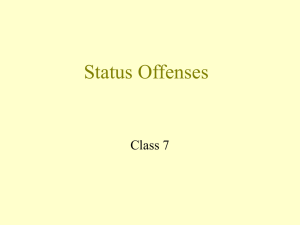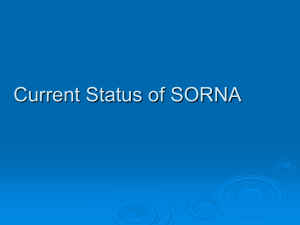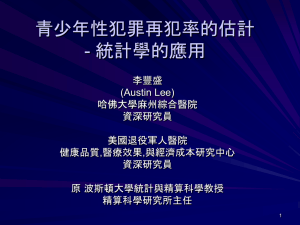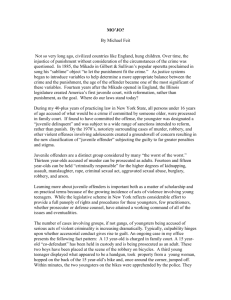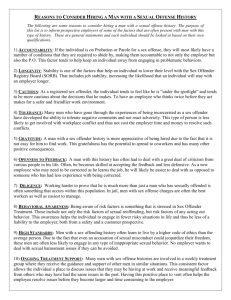JSORN Explained
advertisement
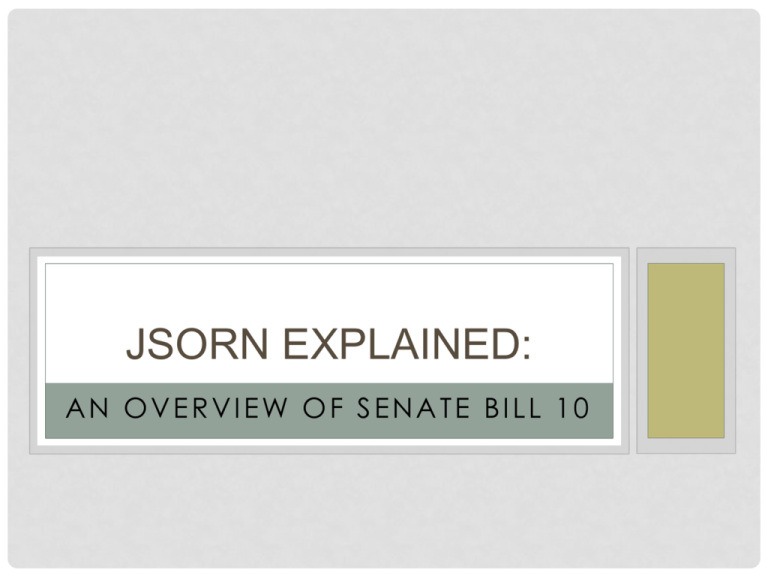
JSORN EXPLAINED: AN OVERVIEW OF SENATE BILL 10 WHERE WE ARE GOING • • • • • • • • The Basics SCO Decisions / Impact Hypotheticals Pending Cases Assessments Placement Issues Impact of Registration Questions THE BASICS Who Must Register? - All youth 16 or 17 at time of offense - All youth 14-17 with a prior adjudication - 14-17 year old serious youthful offenders who are found delinquent of one of six enumerated offenses Who Might Register? - First time 14 and 15 year old offenders - Court must consider factors in R.C. 2152.83(D) prior Who Will Not Register? - Youth who were under 14 at time of offense REGISTRATION ELIGIBLE OFFENSES Tier I (for adults) Tier II (for adults) Tier III (for adults) Importuning Compelling prostitution Rape Unlawful sexual conduct Pandering obscenity involving a minor Sexual battery Voyerism Pandering sexually oriented material involving a minor Aggravated murder with sexual motivation Sexual Imposition Illegal use of a minor in nudity-oriented material Murder with sexual motivation Gross Sexual Imposition Unlawful sexual conduct with a minor when offender is four years older than victim Unlawful death or termination of pregnancy as a result of committing a felony with sexual motivation Illegal use of a minor in nudity-oriented material Gross sexual imposition with victim under 13 Kidnapping of a minor to engage in sexual activity Child enticement with sexual motivation Child endangering Kidnapping of minor, not parent Pandering obscenity Kidnapping with sexual motivation Gross sexual imposition with (B) specification Menacing by stalking with sexual motivation Abduction with sexual motivation Felonious assault with sexual motivation Any offense after offender has already been classified as tier I Any offense that occurs after previous classification as tier II or III *Offense based classification for adults only **Look to the offense of conviction or adjudication, not the complaint THE BASICS CONT’D The Tiers (for Juveniles) Registration Level Frequency of Registration Duration of Registration Tier I Annually Ten years Tier II Every 180 days Twenty years Tier III Every 90 days Until death PRQJOR Every 90 days Until Death THE BASICS CONT’D The Tiers (for Adults) Registration Level Frequency of Registration Duration of Registration Tier I Annually Fifteen years Tier II Every 180 days Twenty-five years Tier III Every 90 days Until death THE BASICS CONT’D JUVENILE • Court has discretion to determine tier level • No residency restrictions • Not posted on the web • Community notification only applies to certain Tier III JORs • Only registers in the county where they live • Can petition to have registration modified or removed • Is a “juvenile offender registrant” even after turning 18/21 ADULT Tiers are offense based Residency restrictions apply Posted on eSORN Community notification applies to all adult registrants • Registers where they live, work, and attend school • Cannot petition to have registration removed • • • • THE BASICS How public is registration? • No more PRQJOR (no youth should be on eSORN) In re C.P., 2012-Ohio-1446 • Tier III: Judicial discretion • Tier I, II, and III: All registrant information is available via public records request R.C. 2950.081 THE HEARINGS The Classification Hearing (R.C. 2152.82 or 2152.83) • For repeat offenders, must happen at disposition (2152.82) • For first-time offenders who are 16 or 17 (2152.83(A)) • If committed to a secure facility, upon release • If not committed to a secure facility, at disposition • For first-time offenders who are 14 or 15 (2152.83(B)) • Can occur at disposition or upon release from a secure facility See In re I.A., 2014-Ohio-3155 THE HEARINGS The End-of-Disposition Hearing (R.C. 2152.84) • Mandatory hearing required when the child completes disposition • Mandatory registrants can step down in tier • Discretionary registrants can come off the registry • Court may not increase registration duties THE HEARINGS Petition for Declassification R.C. 2152.85 • • • • • Three years after the end of disposition hearing Registrant must request hearing (not automatic) Mandatory registrants can come off registry Court must consider factors in R.C. 2152.83(D) Court may not increase youth’s registration duties CASES State v. Bodyke, 126 Ohio St.3d 266, 2010-Ohio-242, 933 N.E.2d 753 • Question: whether the reclassification of Megan’s Law offender registrants under SB 10 was constitutional. • Held: the retroactive application of SB 10 to persons with prior Megan’s Law classifications violated separation of powers. • Remedy: The reclassification provisions of the statutes were stricken; former classifications reinstated. • Implication: No one who was classified under Megan’s Law prior to January 1, 2008 should have a “tier” classification under S.B. 10. CASES State v. Williams, 129 Ohio St.3d 344, 2011-Ohio-3374, 952 N.E.2d 1108 • Question: whether the classification of offenders with pre-SB 10 offenses under SB 10 was constitutional. • Held: SB 10 is punitive; therefore, the retroactive application of it to anyone whose offense predates enactment violates Ohio’s Retroactivity Clause. • Remedy: registrants are to be given new classification hearings under the version of the law in effect at the time of their offense. • Implication: no one whose offense occurred prior to SB 10’s enactment should be a “tiered” offender registrant. CASES In re Bruce S., 134 Ohio St.3d 477, 2012-Ohio-5696, 983 N.E.2d 350 • Clarified that Williams applied to all registrants whose offenses occurred between SB 10’s enactment and its effective date. CASES In re D.J.S., 130 Ohio St.3d 257, 2011-Ohio-5342, 957 N.E.2d 291 • Question: same as the questions presented in Williams • Held: Williams applies to juvenile cases. • Remedy: Juvenile offenders were to be given the same remedy as adults – new classification hearings under the version of the law in effect at the time of their offense (Megan’s Law). • One caveat… CASES In re J.V., 134 Ohio St.3d 1, 2012-Ohio-4961, 979 N.E.2d 1203 • Question: could a juvenile correct an improperimposed SYO sentence after the juvenile offender turned 21? • Held: Juvenile courts do not have jurisdiction to impose a disposition once a child attains the age of 21. CASES Impact of JV on registration cases? • Juveniles whose cases were remanded under Williams/DJS were held (if the juvenile offender had turned 21 already) and their cases were then remanded for application of Williams and JV • The juvenile court was without jurisdiction to hold a Megan’s Law hearing for those juvenile offenders CASES State ex rel Pression Jean-Baptiste v. Kirsch, 134 Ohio St.3d 421, 2012-Ohio-5697, 983 N.E.2d 302 • Question: Did a juvenile court patently and unambiguously lack jurisdiction to classify a juvenile offender who had turned 21? • Held: Juvenile courts lack statutory authority to classify a child as a juvenile offender registrant after the child is released from a secure facility, completes his juvenile disposition, and turns 21. • Implication: If a child has turned 21 and the court has not classified him yet, the court is without jurisdiction to do so. CASES In Re J.B., 134 Ohio St.3d 538, 2012-Ohio-5675, 983 N.E.2d 1295 • The Supreme Court applied Jean-Baptiste to a case where the juvenile had completed his disposition, but had not yet turned 21 – with the result – the court was without jurisdiction to classify him. CASES State v. Gingell, 128 Ohio St.3d 444, 2011-Ohio-1481, 946 N.E.2d 192 • Question: Can a registrant whose classification was rendered unconstitutional be responsible for complying with SB 10’s requirements? • Held: Because the retroactive application of SB 10 was unconstitutional, registrants whose offenses occurred prior to January 1, 2008 are not responsible for complying with SB 10’s requirements. • Remedy: Mr. Gingell’s conviction for failing to comply with SB 10 was vacated. • Implication: a person with a void SB 10 classification (under Bodyke or Williams) cannot be charged with violating SB 10’s failure to register/notify/verify statutes. CASES In re C.P., 131 Ohio St.3d 513, 2012-Ohio-1446, 967 N.E.2d 729 • Question: Is R.C. 2152.86, which governs the classification of public registry-qualified juvenile offender registrants constitutional? • Held: R.C. 2152.86 violates due process and the prohibition against cruel and unusual punishments. • Remedy: R.C. 2152.86 stricken in its entirety. • Implication: The PRQJOR classification is not a valid option for any court. Children with serious youthful offender specifications (tied to registerable offense) are classified like any other potential juvenile registrant. CASES State v. Raber, 134 Ohio St.3d 350, 2012-Ohio-5636, 982 N.E.2d 684 • Question: Can a court reopen the evidentiary phase of the proceedings to prove facts necessary to establish registration eligibility after sentencing? And, can a court impose a classification after sentencing? • Held: A trial court lacks jurisdiction to reconsider a final judgment in a case and because registration is now punishment, classifying an offender at any time other than sentencing violates double jeopardy. • Remedy: unconstitutional classification vacated • Implication: classification must occur at sentencing. CASES In re I.A., 140 Ohio St.3d 203, 2014-Ohio-3155, 16 N.E.3d 653 • Question: Does the language of R.C. 2152.83(B) mandate the timing of the classification hearing for first time 14- and 15-year-old juvenile offenders? • Held: for discretionary registrants (first time 14- and 15year-old juvenile offenders) classification can occur at disposition or upon release from a secure facility. • Implication: this applies to the hearing conducted under R.C. 2152.83(B) only; the language in 2152.83(A) for 16and 17-year-old first-time offenders mandates the timing of the hearing. HYPO At 12 years old, Julie was charged with gross sexual imposition for allegedly touching her 5 year old sister. She admitted to the offense and was placed on probation. 10 months later she was charged with statutory rape of her 9 year old cousin. The court imposed a commitment to a community corrections facility; and, after a year, she was released. Upon her release from the CCF, the court held a hearing and imposed a tier II classification on Julie. Is there anything wrong with the court’s order? HYPO Yes: Julie was not eligible for classification. Her first offense occurred when she was 12. Even though she picked up a subsequent charge, it occurred when she was either 12 or 13. Since children under 14 are not eligible for registration. The juvenile court did not have authority to classify her. HYPO Evan admitted to three counts of rape and one count of gsi for acts that occurred when he was 13. He was not adjudicated delinquent for those offenses until he was 14. He was committed to DYS. While in DYS, he admitted to three more offenses, involving three other victims. They all occurred prior to the offenses for which he was serving his commitment. Do the new offenses make him eligible to be a registrant? HYPO No. The code requires classification for repeat offenders if they have a “prior adjudication.” Even though Evan was 14 when he admitted to the other offenses, he is not eligible for classification for two reasons: 1) he was under 14 when his prior offenses occurred; and 2) even though he committed prior offenses, they were simply prior offenses that had not been charged, not prior adjudications. The code envisions mandatory registrants being youth who commit a new offense following an adjudication, not youth who had unreported priors that are discovered during treatment. HYPO DeMarco was adjudicated delinquent of a sexually oriented offense following a sexting scandal at school. He was 15 at the time. He was placed on probation; and, one year later, when he was 16, he was charged with the forcible rape of a peer. He was sent to DYS without being classified. When he was released, the juvenile court held a classification hearing and found him to be a tier III. Is there anything wrong with the court’s order? HYPO Yes. Because DeMarco was a repeat offender, his classification should have occurred at disposition for the rape. HYPO Andrew admitted to two counts of rape for offenses that occurred when he was 17 years old. He was committed to DYS for two years. In DYS, he was a model youth. He sailed through treatment, made great grades, and was a low security youth. He did so well, the court released him early. Following his release, the court held a classification hearing, where it received and reviewed his treatment records, which were brilliant, and a risk assessment that showed he was a low risk to reoffend. The court classifies him as a tier I juvenile offender registrant. Is that permitted under the law? HYPO Yes, juvenile courts (unlike criminal courts) have discretion to determine a juvenile offender’s tier level. The court is required to consider the results of treatment, professional assessments, the juvenile offender’s remorse, etc., to determine tier. Given how well Andrew did, the court was within statutory permission to classify him as a tier I. HYPO When Lance was 18, he was adjudicated delinquent of a gross sexual imposition that he committed when he was 16. He was committed to DYS and, as a result of getting multiple write-ups for non-sexual bad behavior, he was held until he turned 21 and DYS was required to release him. Upon his release (his 21st birthday), the juvenile court classifies him as a tier II juvenile offender registrant. Was this lawful? HYPO No. Under Jean-Baptiste and JV, because he turned 21, he was no longer a child under R.C. 2152.02(C); and therefore, the court was without jurisdiction to classify him. PENDING ISSUES In re D.S. is pending in the Supreme Court as Case No. 2014-0607 • Issue one: after a discretionary registrant’s release from DYS, may the juvenile court reopen the case to prove additional facts necessary to establish whether the child was age eligible for registration at the time of his offense? • Issue two: because registration is punishment, do the provisions of SB 10 which allow juvenile courts to classify a child upon his release from a secure facility violate double jeopardy? • Issue three: because registration is punishment, can a child’s registration extend beyond the age jurisdiction of the juvenile court? PENDING ISSUES In re M.R., pending as Case No. 2014-1315 • Do the mandatory registration requirements in R.C. 2152.83(A) (mandatory registration of 16- and 17year-olds violate equal protection? ASSESSMENTS • ERASOR: Estimate of Risk of Adolescent Sexual Offenders • J-SORRAT-II: Juvenile Sexual Offense Recidivism Risk Assessment Tool • SAVRY: Structured Assessment of Violence Risk in Youth • J-SOAP-II: Juvenile Sex Offender Assessment Protocol J-SOAP-II – THE MOST COMMON “A checklist to aid in the systemic review of risk factors identified in professional literature as being associated with sexual and criminal offending. It is designed to be used with boys in the age range of 12 to 18 who have been adjudicated for sexual offense, as well as nonadjudicated youths with a history of sexually coercive behavior.” (J-SOAP-II Manual, 2003) HOW IT IS SCORED 23 items, split into 4 scales Each item is a risk factor scored 0, 1, or 2. 0 = apparent absence of item 1 = presence of some info that suggests presence of the item, but it is “too sketchy” to justify a score of 2 • 2 = clear presence of item • • • • J-SOAP-II SUMMARY SCORE Static Score is the majority of the score (32 items vs. 24 items) Total: Avg. score= 21, no offending Avg. score= 30, did reoffend (J-SOAP-II Manual, 2003) ITEMS FROM SCALES 1 & 2 1 2 • • • • • • • • • • • • • • • • Prior legally charged sex offenses Number of sexual abuse victims Male child victim Duration of sexual offense history Degree of planning in sexual offense(s) Sexualized aggression Sexual drive and preoccupation Sexual victimization history Caregiver Consistency Pervasive anger School behavior problems History of conduct disorder before age 10 Juvenile antisocial behavior (age 10-17) Ever charged/arrested before age 16 Multiple types of offenses Physical assault history and/or exposure to family violence PLACEMENT ISSUES • What type of facility is the child being released to? • Does the facility have restrictions that could impact registration? IMPACT OF REGISTRATION • In re C.P., 131 Ohio St.3d 513, 2012-Ohio-1446, 967 N.E.2d 729 • Human Rights Watch: Raised on the Registry – available at: https://www.hrw.org/report/2013/05/01/raisedregistry/irreparable-harm-placing-children-sex-offenderregistries-us • Harris, A.J., Walfield, S., Shields, R.T., & Letourneau, E.J., Collateral Consequences of Juvenile Sex Offender Registration and Notification: Results from a Survey of Treatment Providers, Sexual Abuse: A Journal of Research and Treatment 1-22 (2015). QUESTIONS? MORE QUESTIONS? Also, feel free to contact us at: Office of the Ohio Public Defender Brooke M. Burns Brooke.Burns@opd.ohio.gov 614.466.5394 Franklin County Prosecutor’s Office Christine S. Julian cjulian@franklincountyohio.gov 614.525.3901

